This set of Mechanical Metallurgy Multiple Choice Questions & Answers (MCQs) focuses on “Multiplication of Dislocation”.
1. A ________ is a sharp break in the dislocation line by moving it out of the slip plane. A _______ is a sharp break in the dislocation line, but it remains in the slip plane.
a) jog, kink
b) kink, jog
c) jog, jog
d) kink, kink
View Answer
Explanation: Interaction of two dislocations produce a sharp break in the dislocation line. A jog is a sharp break in the dislocation line by moving it out of the slip plane. A kink is a sharp break in the dislocation line, but it remains in the slip plane.
2. To produce the jog from the intersection of two dislocations, the necessary condition is ______
a) burger vector of the dislocation should be parallel to each other
b) burger vector of the dislocation should be perpendicular to each other
c) burger vector of the dislocation should be directionally opposite to each other
d) burger vector of the dislocation should be at 45 degrees to each other
View Answer
Explanation: If the two dislocations burgers vector is perpendicular to each other, the dislocation interacts with each other at 90 degrees, and this will result in a shift in one of the dislocations and it will shift by one atomic unit out of the slip plane.
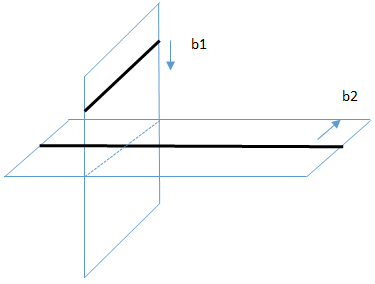
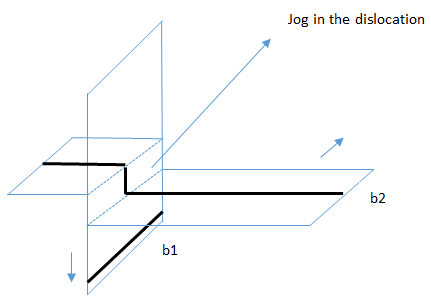
3. To produce the kink from intersection of two dislocations, the necessary condition is ____________
a) burger vector of the dislocation should be parallel to each other
b) burger vector of the dislocation should be perpendicular to each other
c) burger vector of the dislocation should be directionally opposite to each other
d) burger vector of the dislocation should be at 45 degrees to each other
View Answer
Explanation: If the two dislocations burgers vector is parallel to each other, the dislocation interacts with each other on the same plane. This interaction will result in a shift in single dislocations by one atomic unit in the same slip plane.

4. The interaction of screw dislocation and edge dislocation produces ______ on the edge dislocation and _______ on the screw dislocation.
a) a jog with an edge orientation, a kink with an edge orientation
b) a kink with an edge orientation, a jog with an edge orientation
c) a jog with a screw orientation, a kink with a screw orientation
d) a kink with a screw orientation, a jog with a screw orientation
View Answer
Explanation: The interaction of screw and edge dislocation will produce a kink and jog in the screw and edge dislocation, respectively.
5. The interaction of two screw dislocation produces ___________
a) jogs of edge orientation in both screw dislocations
b) kink of edge orientation in both screw dislocations
c) jogs of screw orientation in both screw dislocations
d) kink of screw orientation in both screw dislocations
View Answer
Explanation: The interaction of two screw dislocation is most important in plastic deformation. The interaction produces jogs of edge orientation in both screw dislocations.
6. Edge dislocation moves slowly in a crystal compared to a screw dislocation of same burger vector.
a) True
b) False
View Answer
Explanation: Generally, the movement of a screw dislocation is slower than edge dislocation in crystal because dislocation interaction in crystal creates jog in the original dislocation. The presence of jog in screw dislocation makes it immobile.
7. Is it possible to generate dislocation by thermal activation?
a) Yes
b) No
View Answer
Explanation: The associated energy of per atom in dislocation plane is very high. So it is highly unlikely that this barrier is achieved by thermal activation. Dislocation is generated by mechanical stresses or during solidification process.
8. The metallic tiny whisker are _________
a) bulk metallic glass
b) single crystal with high dislocation
c) tiny projection of the metals with zero dislocation
d) metal foam
View Answer
Explanation: Metallic whiskers are a tiny projection of metal grown from the parent material. They are hair-like structure and does not the grow by the dendritic mechanism. Hence, they generally do not contain dislocations.
9. Which of the following is not a source of dislocation?
a) Grain boundary steps
b) Aggregation and the collapse of vacancy
c) ledges
d) Interstitial atoms
View Answer
Explanation: Grain boundary step and ledges are the well-known sources of dislocation because at curved surfaces, they need dislocation to compensate for mismatch. The Vacancy loop is also the source of dislocation in FCC material. But the Interstitial atoms have no significant impact on creation of dislocation.
10. If there is no source of dislocation multiplication in metal, the cold work of metal will reduce the dislocation density of the given metal.
a) True
b) False
View Answer
Explanation: Cold work moves the dislocation in the metal. If there is no source of dislocation multiplication, the dislocation will end up on the surface of the metal, and finally, the metal will be free from dislocations.
11. In the Frank-Read source of dislocation multiplication, in which of the following steps the shear stress required will be maximum?
Where D D’ are immobile points. Immobile points are shown in black dots, and the dislocation line is shown in the blue line, which is bowing around the black points.
a)

b)
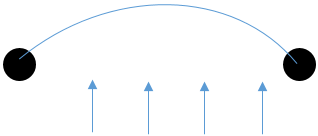
c)
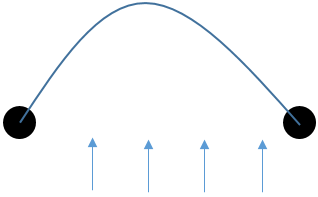
d)
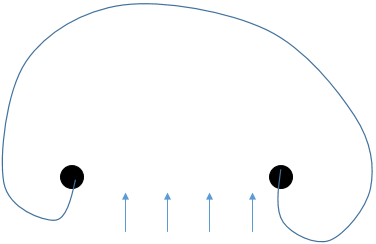
View Answer
Explanation: If we assume the black dots as fixed points, the dislocation will bow around these fixed point. This bowing will be required for additional shear stress to keep the dislocation mobile. So the required shear stress will be maximum when the radius of the dislocation loop is equal to half of the length of the distance between two black points.
12. In the Frank-Read dislocation source, if the distance between fixed points is L, then the minimum possible value of dislocation loop radius will be equal to__________
a) L
b) L/2
c) 2L
d) 3L
View Answer
Explanation: When the dislocation is in this shape, the radius of the loop will be minimum. Before and after this point loop radius will keep on increasing.
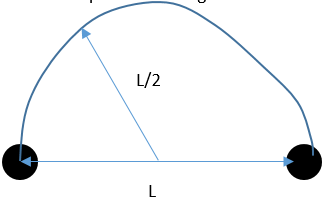
13. In the Frank-Read dislocation source, if the distance between fixed points is L, then the minimum possible value of dislocation loop radius will be equal to L/2. The shear stress required to achieve this point is ____________
a) Gb2
b) 2Gb/L
c) Gb/L
d) Gb2/L
View Answer
Explanation: The shear stress required to achieve this point will be equal to Gb/L. Beyond this point, the required shear stress value will keep on decreasing.
14. In a crystal, there exist a point defect of the interstitial atom. If solute atom is larger than the solvent atom, then which is true for the edge dislocation?
a) Dislocation will always attract to interstitial atom
b) Dislocation will always repeal to interstitial atom
c) Compression side of edge dislocation will repeal and will be attracted to the tension side
d) compression side of edge dislocation will attract and will be repealed to the tension side
View Answer
Explanation: If the solute atom is larger than the solvent, it will create a local region of compression. So the tension side of dislocation will attract at this region, and compression side will repel from this region.
15. If in a crystal there exist a point defect of the interstitial atom and if solute atom smaller than the solvent atom, then which is true for the edge dislocation?
a) Dislocation will always attract to interstitial atom
b) Dislocation will always repeal to interstitial atom
c) Compression side of edge dislocation will repeal and will be attracted to the tension side
d) compression side of edge dislocation will attract and will be repealed to the tension side
View Answer
Explanation: If the solute atom is smaller than the solvent, it will create a local region of tension. So the tension side of dislocation will repeal at this region, and compression side will attract from this region.
Sanfoundry Global Education & Learning Series – Mechanical Metallurgy.
To practice all areas of Mechanical Metallurgy, here is complete set of 1000+ Multiple Choice Questions and Answers.
If you find a mistake in question / option / answer, kindly take a screenshot and email to [email protected]
- Check Mechanical Metallurgy Books
- Apply for Metallurgical Engineering Internship
- Check Metallurgical Engineering Books
- Practice Metallurgical Engineering MCQs
